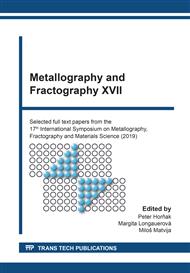p.288
p.294
p.300
p.306
p.312
p.318
p.324
p.333
p.339
Fatigue Behavior of Titanium Endoprosthesis
Abstract:
This paper deals with applications of biomaterial in the human body. Each biomaterial is characterized by biofunctionality and biocompatibility [1]. The choice of biomaterial for medical applications is established on mechanical properties. Therefor the Ti6Al4V alloys, which properties are relatively low modulus, good fatigue strength, formability, machinability, corrosion resistance [2], are most widely used in biomedical replacements, implants, and prosthesis. Despite the excellent properties of the titanium alloy, endoprosthesis often fails and the hip replacement is necessary. Common causes are overloading and cracking, static or dynamic. Other causes of failure include injury, implantation failure, manufacturing inaccuracies, and non-compliance with the manufacturing process.
Info:
Periodical:
Pages:
312-317
Citation:
Online since:
November 2020
Authors:
Keywords:
Price:
Сopyright:
© 2020 Trans Tech Publications Ltd. All Rights Reserved
Share:
Citation:


